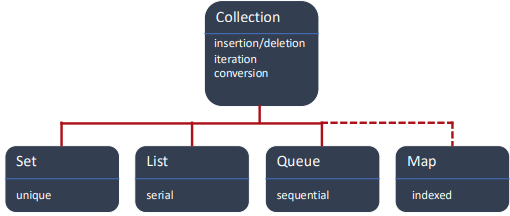The Collections API and Generics
1/13
There's no tags or description
Looks like no tags are added yet.
Name | Mastery | Learn | Test | Matching | Spaced |
|---|
No study sessions yet.
14 Terms
Collections
Just data structures
provide general, reusable implementations of common data structures
are not inherently part of the language per se…
simply implemented as classes
Java Collections
implemented through an interface hierarchy
therefore, all data structures implementation have the same API
classes such as LinkedList implement these interfaces

Collection Interface
public interface Collection<E> {
//basic operations
int size();
boolean isEmpty();
boolean contains(Object element);
boolean containsAll(Collection<?> c);
Iterator<E> iterator();
//add/remove operators
boolean add(E element);
boolean remove(Object element);
boolean addAll(Collection<? extends E> c);
boolean removeAll(Collection<?> c);
boolean retainAll(Collection<?> c);
void clear();
//array operations
Object[] toArray{};
<T> T[] toArray(T[] a);
}List interface
public interface List<E> extends Collection<E>
{
//positional access
E get(int index);
//add/remove operations
E set(int index, E element);
void add(int index, E element);
E remove(int index);
boolean addAll(int index, Collection<? extends E> c);
//search
int indexOf(Object o);
int lastIndexOf(Object o);
//range-view
List<E> subList(int from, int to);
}Set Interface
public interface Set<E> extends Collection<E>
{
//uniqueness operations
boolean equals(Object o);
int hashCode();
}Queue Interface
public interface Queue<E> extends Collection<E>
{
E element(); //return head item - exception if none
E peek(); //return head item - null if none
boolean offer(E e); //add item - false if full
E remove(); //pop head item - exception if none
E poll{}; //pop lead item - null if noneCommon Implementations
ArrayList ordered, indexed list
LinkedList ordered, non-indexed
PriorityQueue FIFO with optional prioritisation
HashSet unique, unordered
TreeSet unique, ordered
HashMap hashed key-value pairs (no ordering)
TreeMap hashed key-value pairs (ordered by key)
Using the Collections API
Collections are classes, so we just treat them as such
Create an object using its constructor
Use its methods to interact with that data structure
Choose the best data structure for your application. ArrayList is a good default…
import java.util.Collections.*;
import java.util.*;
public class University
{
public void doSomething()
{
ArrayList<Person> staff = new ArrayList<>();
staff.add(new Person("Joe"));
staff.add(new Person("Saad"));
}
}ArrayList<Person> = the type of things you want to store
Methods in Collections API
We can use any of the methods defined in the relevant interfaces
add
remove
contains
get
We can also iterate over them in loops
import java.util.Collections.*;
import java.util.*;
public class University
{
public void doSomething()
{
ArrayList<Person> staff = new ArrayList<>();
Person j = new Person("Joe"));
Person s = new Person("Saad");
staff.add(j);
staff.add(j);
for (Person p : staff)
System.out.println(p.getName());
staff.remove(j);
if (staff.contains(s))
System.out.println("Saad is a staff memmber!");
}
}ArrayList
Acts much like an extensible array
Items are maintained in a sequence, add/removed dynamically, etc
Items are also enumerated and indexed by location
Implemented internally as a simple array…
if the array becomes full, a new one is created and the data copied from the old one
ArrayList Complexities
O(1) complexity for index lookups
O(1) complexity for additions (on average!)
O(n) complexity for remove
Makes this a good choice for a general purpose data structure
HashMap
Unordered collection of key/value pairs
Note here we define two types when creating an object (key and value)
put() and get() methods allow us to add/remove objects from the collection
VERY fast. Approaching O(1) for key based addition, deletion, lookup
public class University
{
public void doSomething()
{
Person j = new Person("Joe");
HashMap<String, Person> users = new HashMap<>();
users.put("Finneyj", j);
Person p = users.get("finneyj");
}
}Generics
Classes can be parameterised, just like functions and methods
Class definition can be appended with one or more formal type parameters in angled brackets
These parameters represent types that need to be defined when an object of that class can be created using new…
Within the class, the formal type parameter can be used in instance variables, method signatures…
public class LinkedList<E>
{
private E data;
public E getData()
{
return data;
}
}Using Generics
Formal type parameters bind to real types when objects are created using new
The actual types are defined also in angled brackets at this point
At this point, a new class is generated for that specific type…
...that class is then instantiated, and a strongly typed object reference returned
LinkedList<Person> staff = new LinkedList<Person>();